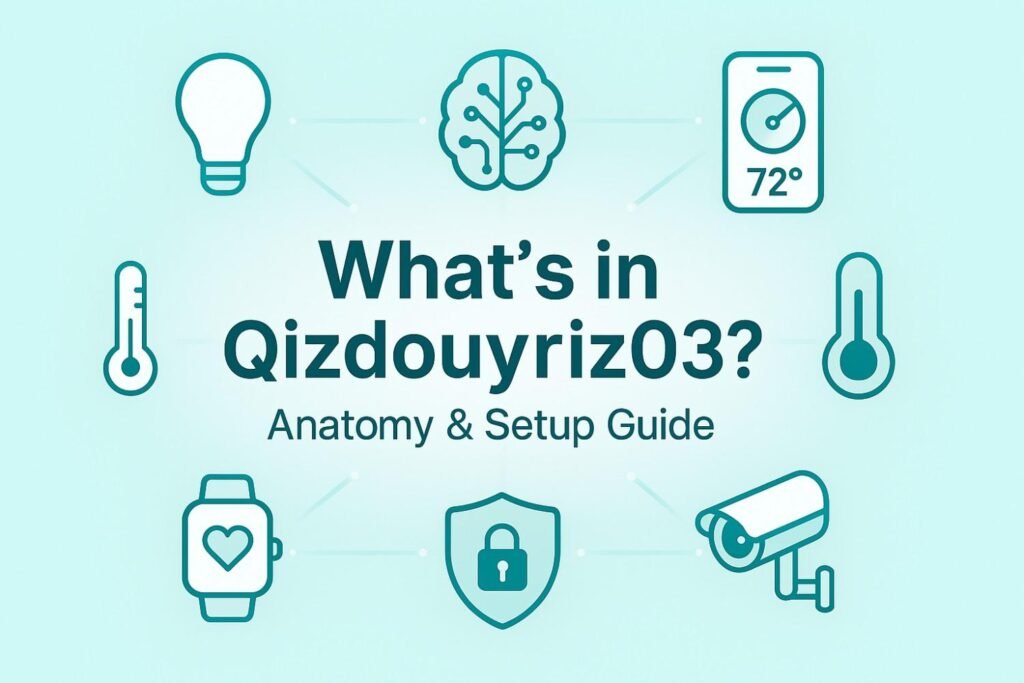What Is Qizdouyriz03 (and What It’s Not)
Think of Qizdouyriz03 as a reference ecosystem: a way to connect your environment (lights, climate, security), your body signals (sleep, stress, movement), and your digital life (calendar, tasks) through a single automation brain. It is not a single gadget—rather, it is how multiple parts cooperate so your space feels intelligent, supportive, and respectful of privacy.
Anatomy: The 6 Layers Inside Qizdouyriz03
1) Edge Devices
Bulbs, switches, plugs, sensors (motion, contact, temp), thermostats, locks, speakers, and cameras. These expose capabilities—on/off, dim, heat/cool, arm/disarm—that the system can chain into scenes.
2) Wearables & Signals
Watches and fitness bands provide sleep stages, HR/HRV, steps, and stress indicators. Optional—but when enabled, routines adapt gently to your state: softer alarms after poor sleep, fewer non-urgent notifications during recovery.
3) Context Graph
A live map of who is where, what devices are available, and when certain modes should apply. It fuses calendar blocks, presence, geofencing, and thresholds like lux levels or temperature.
4) Automation Brain
Combines an AI model with a lightweight rules engine. It recognizes routines (commute, focus, bedtime), then sequences actions: set scenes, adjust climate, schedule breaks, dim screens, or lock up when you leave.
5) Apps & Dashboards
Phone, desktop, and watch views for quick actions, routine editing, and notifications. Expect one-tap modes like Deep Work, Guest, or All-Off + Lock.
6) Data, Privacy & Security
Profiles and permissions per person; encryption in transit/at rest; MFA; and local-first options so sensitive rooms or sensors never leave your network. You can export or delete your data at any time.
Everyday Use Cases (Home, Work, Wellness)
- Morning ramp: Lights warm gradually; thermostat moves from eco to comfort; coffee starts as presence is detected in the kitchen.
- Focus mode: Calendar switches to deep work → lights change to cool white → non-urgent notifications pause → a 90-minute timer begins with a mid-session stretch prompt.
- Arrival & security: When you’re near home, porch lights turn on and the door unlocks for a short window; when you leave, the system arms, locks, and turns off non-essential loads.
- Recovery evening: High stress scores? The system dims, suggests an unwind routine, and delays interruptions until morning.
3 Setup Paths: Minimal, Privacy-First, Power User
Minimal (15–25 minutes)
- Pair 2–4 devices (lamp, plug, sensor, thermostat).
- Create your profile; name rooms clearly.
- Build two scenes: Wake and Focus.
Privacy-First (30–40 minutes)
- Enable MFA and local-only mode for bedrooms and office.
- Set data retention to “review monthly.”
- Create Guest and Kids roles with limited device control.
Power User (45–60 minutes)
- Integrate a wearable and calendar for context-aware scenes.
- Add thresholds (lux, temp, occupancy) to trigger automations.
- Build an “All-Off + Lock + Arm” button near the exit.
Compatibility & Standards (The Short Version)
Most modern smart home brands can be bridged. For reliability, keep critical automations (locks, security, night lighting) on your local network and name devices consistently: Room – Device – Purpose (e.g., “Office – Desk Lamp – Task”).
Myths vs Facts
- Myth: “It’s only for techies.”
Fact: Start with two scenes; the system can learn the rest. - Myth: “Wearables are mandatory.”
Fact: Optional. They unlock gentler alarms and stress-aware routines but are not required. - Myth: “Privacy and convenience can’t coexist.”
Fact: Local-first modes and role-based access give you both.
Troubleshooting & Performance Tuning
- Missed triggers? Reduce Wi-Fi congestion; move critical automations to local scenes.
- Over-automation? Add quiet hours and cap the number of suggestions per day.
- Inconsistent names? Standardize naming; re-tag devices by room and purpose.
- Battery drain? Lower sensor report frequency and disable non-essential background checks.
Adopter Checklist
- Pick a starter kit (hub + 2–4 devices).
- Create profiles and roles (Owner, Guest, Kids).
- Enable MFA; set data retention and export options.
- Connect calendar; define focus/meeting modes.
- Optionally integrate a wearable for adaptive routines.
- Build three scenes: Wake, Focus, Wind-down.
- Review weekly; keep what helps, mute what doesn’t.
FAQs
Is Qizdouyriz03 a single product?
No. It’s an ecosystem pattern where devices, signals, and apps coordinate through an automation brain.
Do I need the wearable part?
Not required. It simply adds context so scenes adapt to sleep and stress levels.
Will my current devices work?
Most popular brands can be bridged. Keep mission-critical actions local for speed and reliability.
How private is it?
You’re in control: enable MFA, choose local-only processing for sensitive rooms, and set clear permissions per role.
What’s the fastest win?
Automate your morning ramp and deep-work blocks—high impact, low effort.
Bottom Line
If you’re wondering what’s in qizdouyriz03, the answer is a coordinated stack: smart devices + optional body signals + an automation brain + simple controls, all wrapped in robust privacy. Start small, keep it local where it matters, and iterate weekly.

